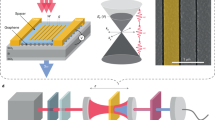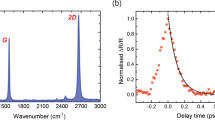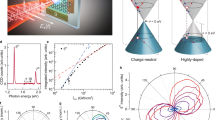Abstract
Optical harmonic generation occurs when high intensity light (>1010 W m–2) interacts with a nonlinear material. Electrical control of the nonlinear optical response enables applications such as gate-tunable switches and frequency converters. Graphene displays exceptionally strong light–matter interaction and electrically and broadband tunable third-order nonlinear susceptibility. Here, we show that the third-harmonic generation efficiency in graphene can be increased by almost two orders of magnitude by controlling the Fermi energy and the incident photon energy. This enhancement is due to logarithmic resonances in the imaginary part of the nonlinear conductivity arising from resonant multiphoton transitions. Thanks to the linear dispersion of the massless Dirac fermions, gate controllable third-harmonic enhancement can be achieved over an ultrabroad bandwidth, paving the way for electrically tunable broadband frequency converters for applications in optical communications and signal processing.
This is a preview of subscription content, access via your institution
Access options
Access Nature and 54 other Nature Portfolio journals
Get Nature+, our best-value online-access subscription
$29.99 / 30 days
cancel any time
Subscribe to this journal
Receive 12 print issues and online access
$259.00 per year
only $21.58 per issue
Buy this article
- Purchase on Springer Link
- Instant access to full article PDF
Prices may be subject to local taxes which are calculated during checkout




Similar content being viewed by others
References
Shen, Y. R. The Principles of Nonlinear Optics (John Wiley & Sons, NY, 1984).
Butcher, P. N. & Cotter, D. The Elements of Nonlinear Optics (Cambridge University Press, Cambridge, 1991).
Franken, P. A., Hill, A. E., Peters, C. W. & Weinreich, G. Generation of optical harmonics. Phys. Rev. Lett. 7, 118–119 (1961).
Stolen, R. H., Bjorkholm, J. E. & Ashkin, A. Phase-matched three-wave mixing in silica fiber optical waveguides. Appl. Phys. Lett. 24, 308 (1974).
Armstrong, J. A., Bloembergen, N., Ducuing, J. & Pershan, P. S. Interactions between light waves in a nonlinear dielectric. Phys. Rev. 127, 1918 (1962).
Steinmeyer, G., Sutter, D. H., Gallmann, L., Matuschek, N. & Keller, U. Frontiers in ultrashort pulse generation: pushing the limits in linear and nonlinear optics. Science 286, 1507–1512 (1999).
Chang, J. J., Warner, B. E., Dragon, E. P. & Martinez, M. W. Precision micromachining with pulsed green lasers. J. Laser Appl. 10, 285 (1998).
Garmire, E. Nonlinear optics in daily life. Opt. Express 21, 30532–30544 (2013).
Miller, G. D. et al. 42%-efficient single-pass cw second-harmonic generation in periodically poled lithium niobate. Opt. Lett. 22, 1834–1836 (1997).
Cerullo, G. & De Silvestri, S. Ultrafast optical parametric amplifiers. Rev. Sci. Instrum. 74, 1 (2003).
Bosenberg, W. R., Drobshoff, A., Alexander, J. I., Myers, L. E. & Byer, R. L. 93% pump depletion, 3.5-W continuous-wave, singly resonant optical parametric oscillator. Opt. Lett. 21, 1336–1338 (1996).
Corkum, P. B. Plasma perspective on strong field multiphoton ionization. Phys. Rev. Lett. 71, 1994–1997 (1993).
Corkum, P. B. & Krausz, F. Attosecond science. Nat. Phys. 3, 381–387 (2007).
Ferguson, B. & Zhang, X.-C. Materials for terahertz science and technology. Nat. Mater. 1, 26–33 (2002).
Shcherbakov, M. R. et al. Enhanced third-harmonic generation in silicon nanoparticles driven by magnetic response. Nano. Lett. 14, 6488–6492 (2014).
Chen, R., Lin, D. L. & Mendoza, B. Enhancement of the third-order nonlinear optical susceptibility in Si quantum wires. Phys. Rev. B 48, 11879–11882 (1993).
Tsang, T. Y. F. Surface-plasmon-enhanced third-harmonic generation in thin silver films. Opt. Lett. 21, 245–247 (1996).
Cai, W., Vasudev, A. P. & Brongersma, M. L. Electrically controlled nonlinear generation of light with plasmonics. Science 6050, 1720–1723 (2011).
Corcoran, B. et al. Green light emission in silicon through slow-light enhanced third-harmonic generation in photonic-crystal waveguides. Nat. Photon. 3, 206–210 (2009).
Seyler, K. L. et al. Electrical control of second-harmonic generation in a WSe2 monolayer transistor. Nat. Nanotech. 10, 407–411 (2015).
Hendry, E., Hale, P. J., Moger, J., Savchenko, A. K. & Mikhailov, S. A. Coherent nonlinear optical response of graphene. Phys. Rev. Lett. 105, 097401 (2010).
Wang, G. et al. Giant enhancement of the optical second-harmonic emission of WSe2 monolayers by laser excitation at exciton resonances. Phys. Rev. Lett. 114, 097403 (2015).
Liu, H. et al. High-harmonic generation from an atomically thin semiconductor. Nat. Phys. 13, 262–265 (2017).
Saynatjoki, A. et al. Ultra-strong nonlinear optical processes and trigonal warping in MoS2 layers. Nat. Commun. 8, 893 (2017).
Klein, J. et al. Electric-field switchable second-harmonic generation in bilayer MoS2 by inversion symmetry breaking. Nano. Lett. 17, 392–398 (2017).
Sun, Z. et al. Graphene mode-locked ultrafast laser. ACS Nano 4, 803–810 (2010).
Bonaccorso, F., Sun, Z., Hasan, T. & Ferrari, A. C. Graphene photonics and optoelectronics. Nat. Photon. 4, 611–622 (2010).
Mikhailov, S. A. Theory of the giant plasmon-enhanced second-harmonic generation in graphene and semiconductor two-dimensional electron systems. Phys. Rev. B 84, 045432 (2011).
Dean, J. J. & van Driel, H. M. Graphene and few-layer graphite probed by second-harmonic generation: theory and experiment. Phys. Rev. B 82, 125411 (2010).
An, Y. Q., Nelson, F., Lee, J. U. & Diebold, A. C. Enhanced optical second-harmonic generation from the current-biased graphene/SiO2/Si(001) structure. Nano. Lett. 13, 2104–2109 (2013).
An, Y. Q., Rowe, J. E., Dougherty, D. B., Lee, J. U. & Diebold, A. C. Optical second-harmonic generation induced by electric current in graphene on Si and SiC substrates. Phys. Rev. B 89, 115310 (2014).
Mikhailov, S. A. Quantum theory of the third-order nonlinear electrodynamic effects of graphene. Phys. Rev. B 93, 085403 (2016).
Rostami, H. & Polini, M. Theory of third-harmonic generation in graphene: a diagrammatic approach. Phys. Rev. B 93, 161411 (2016).
Cheng, J. L., Vermeulen, N. & Sipe, J. E. Third order optical nonlinearity of graphene. N. J. Phys. 16, 053014 (2014).
Rostami, H., Katsnelson, M. I. & Polini, M. Theory of plasmonic effects in nonlinear optics: the case of graphene. Phys. Rev. B 95, 035416 (2017).
Kumar, N. et al. Third harmonic generation in graphene and few-layer graphite films. Phys. Rev. B 87, 121406(R) (2013).
Alexander, K., Savostianova, N. A., Mikhailov, S. A., Kuyken, B. & Van Thourhout, D. Electrically tunable optical nonlinearities in graphene-covered SiN waveguides characterized by four-wave mixing. ACS Photonics 4, 3039–3044 (2017).
Casiraghi, C. et al. Rayleigh imaging of graphene and graphene layers. Nano. Lett. 7, 2711–2717 (2007).
Mak, K. F. et al. Measurement of the optical conductivity of graphene. Phys. Rev. Lett. 101, 196405 (2008).
Mañes, J. L. Symmetry-based approach to electron-phonon interactions in graphene. Phys. Rev. B 76, 045430 (2007).
Woodward, R. I. et al. Characterization of the second- and third-order nonlinear optical susceptibilities of monolayer MoS2 using multiphoton microscopy. 2D Mater. 4, 011006 (2017).
Brida, D. et al. Ultrafast collinear scattering and carrier multiplication in graphene. Nat. Commun. 4, 1987 (2013).
Breusing, M. et al. Ultrafast nonequilibrium carrier dynamics in a single graphene layer. Phys. Rev. B 83, 153410 (2011).
Lazzeri, M., Piscanec, S., Mauri, F., Ferrari, A. C. & Robertson, J. Electron transport and hot phonons in carbon nanotubes. Phys. Rev. Lett. 95, 236802 (2005).
Piscanec, S., Lazzeri, M., Mauri, F., Ferrari, A. C. & Robertson, J. Kohn anomalies and electron–phonon interactions in graphite. Phys. Rev. Lett. 93, 185503 (2004).
Li, X. S. et al. Large-area synthesis of high-quality and uniform graphene films on copper foils. Science 324, 1312–1314 (2009).
Ferrari, A. C. & Basko, D. M. Raman spectroscopy as a versatile tool for studying the properties of graphene. Nat. Nanotech. 8, 235–246 (2013).
Ferrari, A. C. et al. Raman spectrum of graphene and graphene layers. Phys. Rev. Lett. 97, 187401 (2006).
Cancado, L. G. et al. Quantifying defects in graphene via Raman spectroscopy at different excitation energies. Nano. Lett. 11, 3190–3196 (2011).
Bruna, M. et al. Doping dependence of the Raman spectrum of defected graphene. ACS Nano 8, 7432–7441 (2014).
Bonaccorso, F. et al. Production and processing of graphene and 2D crystals. Mater. Today 15, 564–589 (2012).
Das, A. et al. Monitoring dopants by Raman scattering in an electrochemically top-gated graphene transistor. Nat. Nanotech. 3, 210–215 (2008).
Basko, D. M., Piscanec, S. & Ferrari, A. C. Electron–electron interactions and doping dependence of the two-phonon Raman intensity in graphene. Phys. Rev. B 80, 165413 (2009).
Novoselov, K. S. et al. Two-dimensional atomic crystals. Proc. Natl Acad. Sci. USA 102, 10451–10453 (2005).
Xia, J., Chen, F., Li, J. & Tao, N. Measurement of the quantum capacitance of graphene. Nat. Nanotech. 4, 505–509 (2009).
Acknowledgements
We acknowledge funding from EU Graphene Flagship, ERC Grant Hetero2D, and EPSRC grants EP/K01711X/1, EP/K017144/1, EP/N010345/1 and EP/L016087/1.
Author information
Authors and Affiliations
Contributions
A.C.F, G.C. and G.S. conceived and designed the experiments. G.S. and G.W. prepared the experimental set-up. G.S., G.W, S.D.C., M.C. and S.A.B. performed the THG experiments. G.S. analysed the THG data. A.K.O. and D.Y. measured the Raman spectra. D.G.P., T.M., B.L., D.D.F., J.W., J.E.M. and I.G. prepared the samples. H.R. and A.T. developed the THG theory and model for Te. G.S., A.C.F., G.C. and M.P. wrote the paper, with input from all authors.
Corresponding authors
Ethics declarations
Competing interests
The authors declare no competing interests.
Additional information
Publisher’s note: Springer Nature remains neutral with regard to jurisdictional claims in published maps and institutional affiliations.
Supplementary information
Rights and permissions
About this article
Cite this article
Soavi, G., Wang, G., Rostami, H. et al. Broadband, electrically tunable third-harmonic generation in graphene. Nature Nanotech 13, 583–588 (2018). https://doi.org/10.1038/s41565-018-0145-8
Received:
Accepted:
Published:
Issue Date:
DOI: https://doi.org/10.1038/s41565-018-0145-8
This article is cited by
-
Numerical study of transient absorption saturation in single-layer graphene for optical nanoscopy applications
Scientific Reports (2024)
-
Compact terahertz harmonic generation in the Reststrahlenband using a graphene-embedded metallic split ring resonator array
Nature Communications (2024)
-
Strong second-harmonic generation by sublattice polarization in non-uniformly strained monolayer graphene
Nature Communications (2023)
-
Enhancing third harmonic generation using a mid-infrared graphene plasmonic waveguide
Optical and Quantum Electronics (2023)
-
Electrically regulating nonlinear optical limiting of metal-organic framework film
Nature Communications (2022)



